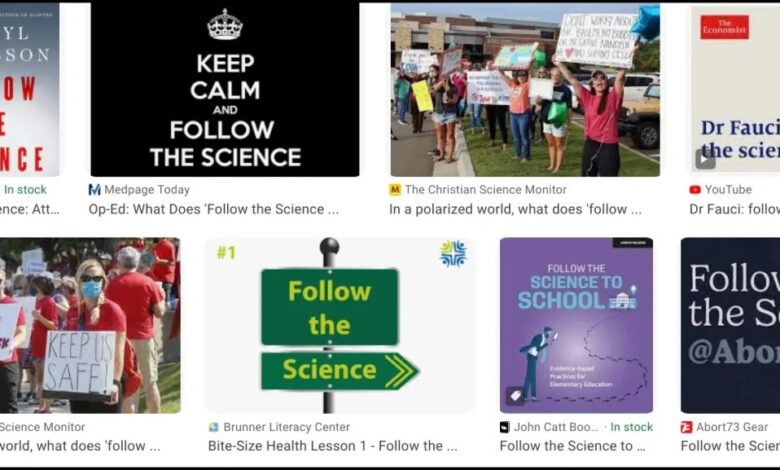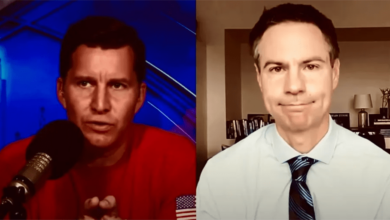Weaponizing ‘The Science’ – Watts Up With That?

Guest Opinion by Kip Hansen – 9 February 2024 — 2000 words/13minutes
Two of my favorite substackers, William “Matt” Briggs and Roger Pielke Jr., have articles up that touch on the subject of what is disparagingly known as “The Science”.
The initial caps version – The Science – invariably means the opinions about some scientific subject held by those telling you to Follow The Science. It very often means a strong consensus position being promoted or enforced by a group advocating some particular belief about a scientific topic or policy position prescribed by those holding that belief. And there are too many of these today to list – one The Science for almost each and every topic you might choose to mention.
Now, there is nothing wrong with any group, even a professional association, like the American Heart Association, the American Lung Association (ALA) or the American Academy of Pediatrics (AAP), having a group consensus position on a topic that falls under their purview. The AAP even has whole section of their website dedicated to advocacy, which includes such things as advocating to keeping guns out of the reach and hands of kids and making sure kids get their childhood illnesses vaccinations.
The problem comes when we see things like this, as related by Pielke Jr.:
“In September, 2022 California Governor Gavin Newsome signed into law a bill that prohibited medical professionals from sharing “misinformation” with patients. Specifically, the law stated that it would be:
[U]nprofessional conduct for a physician and surgeon to disseminate misinformation or disinformation related to COVID-19.
The law defined “misinformation”:
“Misinformation” means false information that is contradicted by contemporary scientific consensus contrary to the standard of care.”
And there you have it….California passed a law that threatens the professional license of any medical professional who shares their professional opinion or any information that contradicts a “contemporary scientific consensus”. It is considered “false” because it contradicts the current consensus. And in this case about a topic that has a lot of controversy and a broad range of opinion.
The “contemporary scientific consensus” thus becomes legally enforceable under State law.
Let’s parse that:
Contemporary: If a thing, an idea, an opinion, or a consensus is contemporary is just means it “exists now”. The fact that it could or does “exist now” means that it could have been different in the past and might be different in the future.
Scientific: Simply means “Scientific is used to describe things that relate to science or to a particular science”. When “scientific” is used as an adjective in today’s language, it is often used as code word for “true or truth”.
Consensus: Even the meaning of the word “consensus” is a bit controversial. Its core meaning is that of “a generally accepted opinion; wide agreement”. Some dictionaries use “unanimity” as a synonym but unanimity means “agreement by all people involved”, which is close but gets no prize. There will be varying opinions, but for this essay today, I will differentiate between consensus – something which is generally accepted or has wide agreement – as different from unanimity which carries the concept that everyone agrees. This is a bit tricky because a consensus reached by a democratic group would be a statement with which all, or almost all, can agree.
Pielke Jr. argues like this: “The notion of consensus-as-truth has been operationalized in various forms: journalistic “fact checkers,” academic “misinformation” researchers, and content moderation on social media platforms. The practical effect is the creation of self-appointed arbiters of truth — journalists, academics, social media platforms, and even governments — who render judgments on acceptable and unacceptable speech according to conformance with an acceptable view.”
And goes on to say:
“The notion of consensus-as-truth can create obstacles to improving understandings. In re-reading Oreskes 2004 on climate consensus for the first time in a while I was struck by this comment:
This analysis shows that scientists publishing in the peer-reviewed literature agree with IPCC, the National Academy of Sciences, and the public statements of their professional societies. [Oreskes 2004]
This is completely backwards — scientific assessments are an interpretive snapshot of what a scientific literature says about specific scientific claims. When done properly, they are a useful characterization of what is often a large amount of published research. But make no mistake — the scientific literature does not “agree” with assessments, the literature informs the assessments.” [ emphasis mine – kh ]
The assessments Pielke Jr. refers to are the “consensus statements” arrived at by the IPCC committees in the science chapters, by far more often, the consensus statements agreed upon by the politicians writing the Summaries for Policy Makers, which then get represented in the media as talking points as the “contemporary scientific consensus” on climate change – by which the media and politicians really mean “the truth about climate change”.

Peilke Jr. uses this illustration from Clark et al. 2023 to make a point about the “consequence[s] of scientific censorship” noting that “Assume that each piece of evidence is equally weighty. Censorship that obstructs evidence against X will produce a peer-reviewed literature that concludes that X is true when most likely it is not.“ There are 11 papers which conclude “X is not true” and only 6 which conclude “X is true”, but 5 “X is true” were published, and only 1 “X is not true” got past the academic censorship and made it into press.
Have we seen this recently? Of course, in the Covid Origin Wars and consistently for many years in the Climate Wars.
When Clark or Pielke Jr. use the word “censorship” they don’t just mean that a specific person or viewpoint is forbidden to be spoken or printed. Academic Censorship is when academic journals consciously, out of fear of pushback or out of blatant bias either refuse publish, refuse to consider or refuse even to send for review papers that on their face are contradictory to consensus positions. In the image with stars we see only one dissenting paper made it into press.
We saw this regarding a paper from Alimonti et al. just last year in which a team of Climate Crisis scientists raised havoc in the mass media (really, Climate Crisis News Cabal outlets) and bullied the editors of a high ranking scientific publisher to retract an already peer-reviewed, approved, and published paper. [ here, here, here ]. The authors tell the story from their viewpoint here: .pdf.
And what about the censorship-by-bias in the Main Stream Media? You only see or hear news when some news outlet makes the decision to have a journalist cover a story and then decides to publish it. Even if actually published, a story may be “buried on page 29”. In our electronic world, only front-page stories or pages elected for broad exposure as “click bait” or “push news” arrive at the majority of readers/viewers. Which stories those are results from decisions of editors who are constrained by their Editorial Boards and Editorial Narratives.
William “Matt” Briggs takes a slightly different approach – he is, after all, a statistician. He talks about the probability of some proposition, written in statistician-ese as Pr(Y). Pr mean ‘the probability of” and of Y, being the proposition, such as Covid originated in a Lab in China, based on the Evidence provided to be considered E, which in the end becomes Pr(Y|E) – read as “the probability of Y given evidence E”.
That, he says, “is, or should be, all of science.“
Every science finding, every point of scientific “truth” is based on a Pr(Y|E), the probability of the proposition “Y” [ say, rising CO2 concentrations in the atmosphere cause dangerous global warming ] being true —- wait for it, here is the pivot point —- given this particular set of evidence “E”.
If one changes the set of evidence, adds something or subtracts something, as we do everyday in the journals of science, then the Pr(Y|E) changes because the “E” has changed – and you can not and do not ever ever ever (like really, never) have simply a probability of Y – it must be, is always always always Pr(Y|E). The probability, you can just consider this as meaning “the probability that this statement / view / proposition / etc. is true, depends entirely on the whole set of evidence as presented — change the evidence = change the probability of truth.
“Scientists should announce their Y and E, and then state Pr(Y|E)—and then stop. Since the E picked by scientists (with some exceptions for mathematicians and the like) won’t be necessarily true, and only contingent, all need to consider what different evidence would do to Y.
In any case, it is always scientism to say “Pr(Y|E) means we should all do the following”, and this is so even if there are no problems whatsoever with Pr(Y|E). From this it follows that nearly all research that involves statistics is deeply saturated in scientism.“
And when someone says “we should all do the following” – that we should Follow The Science — then we have left the field of Science and entering into the hazy domain of Scientism.
And even if we all believed with all our hearts on that Pr(Y|E) – the probability that proposition Y given evidence E being true is nearly 100% – that doesn’t mean that we would all make the same decisions about what to do about it. We wouldn’t necessarily follow, nor should we.
Why? It’s the Evidence, stupid!
Science didn’t stop being done last year, or even yesterday – so the cumulative evidence supporting last year’s “contemporary scientific consensus” has changed already and will change more in the future.
Going back to Pielke Jr., he wraps up with these two statements:
“The notion that scientists should agree with a consensus is contrary to how science advances — scientists challenge each other, ask difficult questions and explore paths untaken. Expectations of conformance to a consensus undercuts scientific inquiry. It also lends itself to the weaponization of consensus to delegitimize or deplatform inconvenient views, particularly in highly politicized settings.”
Followed by:
“A recent study of scientific censorship by scientists by Clark et al. 2023 finds that pressures by scientists on their peers to conform to a consensus are fairly common within the scientific community:
Confirmation bias and other forms of motivated cognition can fuel a self-reinforcing dynamic in which censorship and self-censorship discourage empirical challenges to prevailing conclusions, encouraging a false consensus that further discourages dissent.“
Bottom Lines:
1. “There is no such thing, therefore, [as] Following The Science.” – William Briggs
2. Science changes moment to moment – as new evidence is produced and found for and against various hypotheses.
3. Generally accepted understandings of scientific topics – commonly referred to as “consensuses” – are themselves momentary and must be allowed to change as evidence changes.
4. Enforcing a consensus view, in any manner, is anti-science and calls to “Follow the Science” are always made to enforce some consensus and thus also anti-science.
And, a final word: The California law, mentioned at the beginning of the essay, has been repealed, after being shot down by the courts.
# # # # #
Author’s Comment:
Read the two substack pieces from Pielke Jr. and Briggs (here and here). Worth the effort.
My ongoing series on Monarch Butterflies is an example of the changing of a consensus by new evidence – albeit by just a little. Once Chip Taylor weighed in, the pre-existing consensus began to crack. In a couple more years, the consensus will have shifted considerably.
Even the Skeptical Climate View shifts and changes as time goes on and more and broader evidence is presented for and against the prevailing consensus view.
Enforced consensus is tyranny and is destructive of the scientific enterprise.
Learn to spot when consensus enforcing is taking place – and don’t fall for it. Brute force methods, think Michael Mann et al, are obvious – biased journal editing is much more subtle.
Thanks for reading.
# # # # #




